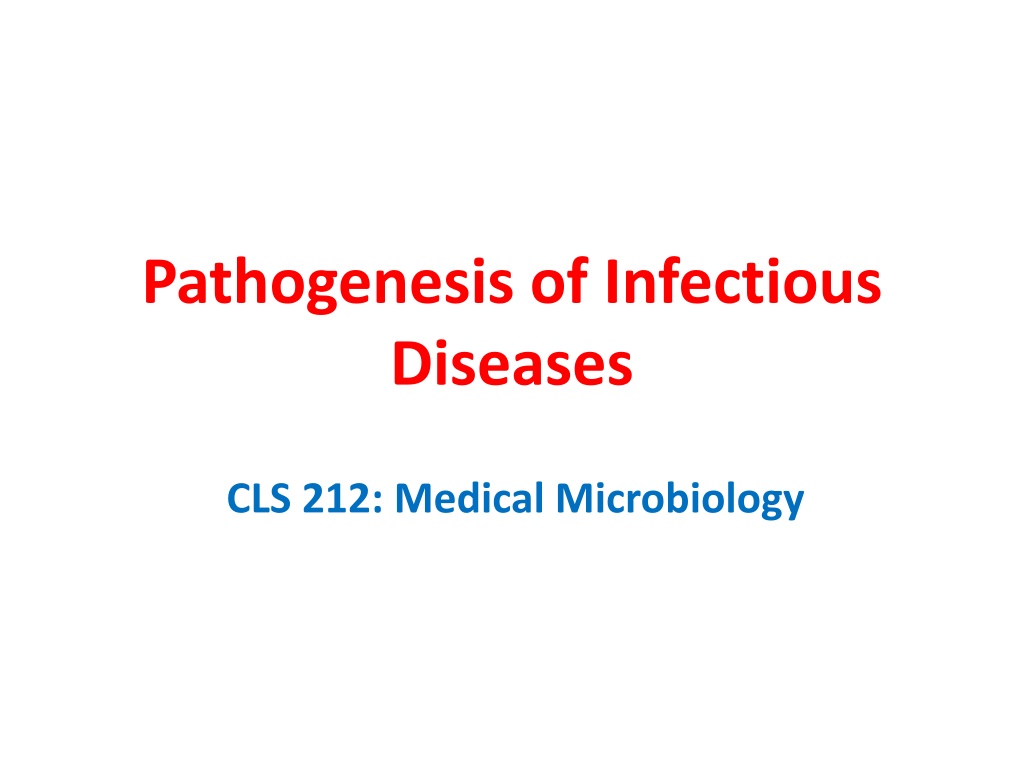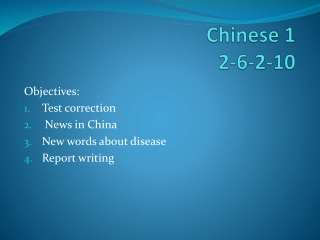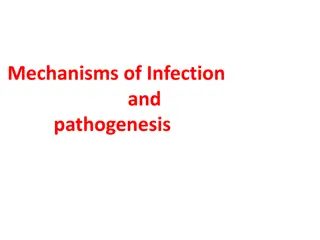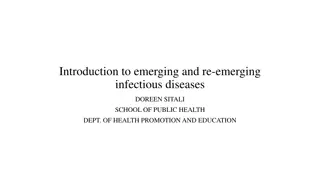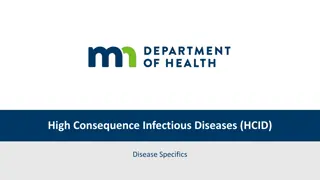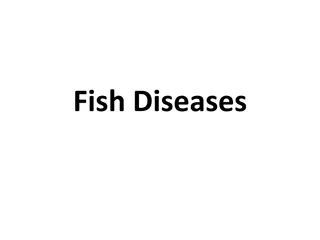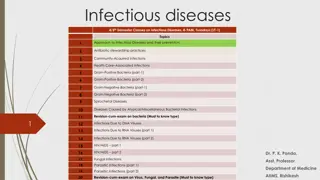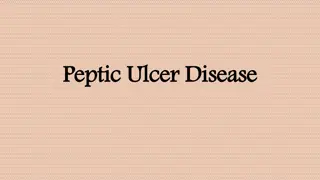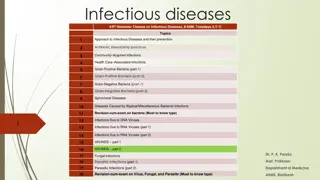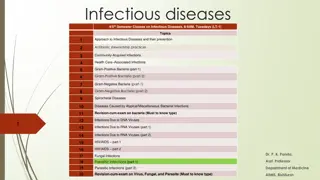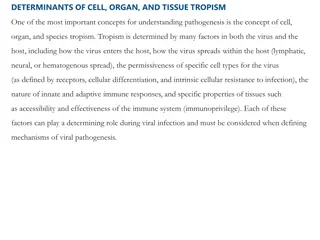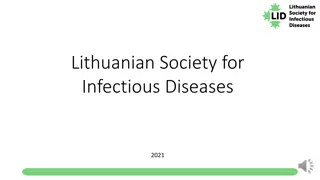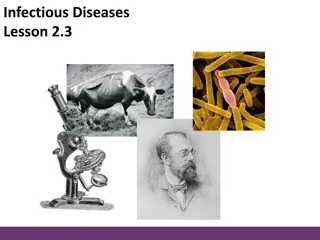Understanding the Pathogenesis of Infectious Diseases
The pathogenesis of infectious diseases involves the development of a disease caused by a pathogen, with phases like incubation, prodromal, illness, and convalescent periods. Infections can be localized or systemic, acute, subacute, or chronic. Differentiating signs and symptoms, recognizing latent infections, and understanding virulence are crucial aspects. The steps in the pathogenesis include entry, attachment, colonization, and invasion.
Download Presentation

Please find below an Image/Link to download the presentation.
The content on the website is provided AS IS for your information and personal use only. It may not be sold, licensed, or shared on other websites without obtaining consent from the author. Download presentation by click this link. If you encounter any issues during the download, it is possible that the publisher has removed the file from their server.
E N D
Presentation Transcript
Pathogenesis of Infectious Diseases CLS 212: Medical Microbiology
Definitions Path- means disease. Pathogenesis The steps or mechanisms involved in the development of a disease. Infection The presence and colonization of a pathogen in human body. Infectious Disease Is a disease caused by a pathogen (microorganism). Not all pathogens entering human body will cause disease because humans are protected by normal flora and the immune system.
Course of an Infectious Disease There are 4 phases or periods in any infectious disease: 1. The incubation period: The time between entry of the pathogen and the onset of symptoms. 2. The prodromal period: The time when the person feels abnormal and week. 3. The period of illness: The time when the person feels typical symptoms associated with that specific disease. 4. The convalescent period: The time when the person recovers from the infection but may develop permanent damage to the area of infection.
Localized vs. Systemic Infection Localized Infection The pathogen is only present at the original site of infection (eg. Pimples or abscesses) Systemic Infection (Generalized) The pathogen is carried to other parts of the body by blood, lymph,..
Acute, Subacute, and Chronic Disease Acute Disease Rapid onset of disease and rapid recovery. e.g. Influenza, measles,.. Chronic Disease Slow onset of disease and last a long time. e.g. Tb, syphilis,.. Subacute Disease The disease with onset less than acute but more than chronic. e.g. bacterial endocarditis.
Signs vs. Symptoms A Sign of a Disease Evidence of disease found or seen by the doctor e.g. abnormal heart or breath sounds, blood pressure, LAB results, radiology,.. A Symptom of a Disease Evidence of disease felt and explained by the patient e.g. headache, stomachache, pain, nausea, itching,..
Latent Infections infectious disease may go from symptomatic to asymptomatic, and then some time later go back to being symptomatic again. Eg. Herpes virus infections Virulence ( virulent ) Is the degree of pathogenicity of an organism, i.e. the relative ability of a pathogen to cause disease. See page 242 , chapter 14
Steps in the Pathogenesis of Infectious Diseases 1. Entry. 2. Attachment. 3. Colonization. 4. Invasion. 5. Immune response Inhibitors. 6. Damage to the host.
1. Entry Penetration of skin most microorganism gain entry via trauma. Introduction of pathogen by an arthropod. Inhalation (respiratory tract) Ingestion (gastrointestinal tract) Through genitourinary tract. Introduction of the pathogen directly into the blood (eg. Blood transfusion, use of shared needles) Skin is very difficult to penetrate,
II. Attachment (Adhesion) Microorganisms have macromolecules (proteins or carbohydrates) that promote attachment to tissue surfaces. Viruses and many bacteria must first bind to host cell surfaces. Prevents early clearance. Pathogens often bind host tissues via surface receptors. e.g. pili in bacteria.
2. Attachment (=Adherence) It is a necessary first step in the establishment of infection. Once they have attached themselves to host cells, they then multiply to high enough numbers to produce toxin or invade host tissue or both. Bacteria use adhesions to attach themselves to host cells (can be found on capsules cell wall proteins or tips of pili).
2. Attachment (=Adherence) The surface receptors on animal cells to which the bacteria attach are usually glycoproteins or glycolipids. Binding of an adhesion to surface receptor is highly specific, dictating the type of cells to which the bacterium can attach. Example: E.coli strains that cause (UTI) urinary tract infections generally produce a type of pili that attach to bladder cells. While E.coli strains that cause watery diarrhea produce a type of pili that attach specifically to cells of small intestine.
2. Attachment (=Adherence) Eg. E.coli strains that cause urinary tract infections generally produce a type of pili that attach to bladder cells. While E.coli strains that cause watery diarrhea produce a type of pili that attach specifically to cells of small intestine.
III. Colonization Some virulent bacteria produce special proteins that allow them to colonize parts of the host body. Pathogens start multiplication and maintenance. Pathogens compete with normal flora for residence. Pathogens will resist body reactions e.g. Bile, stomach acid, skin secretions, IgA (mucosal antibodies). e.g. Helicobacter pylori is able to survive in the acidic environment of the human stomach by producing the enzyme urease.
4. Invasion Some virulent bacteria produce proteins that either: a. Disrupt host cell membranes or b. Stimulate endocytosis into host cells Endocytosis is the process by which cells absorb material (molecules such as proteins) from outside the cell by engulfing it with their cell membrane Eg. Mycobacterium tuberculosis produces surface proteins that facilitate their uptake by the alveolar macrophages. And so the macrophage is not activated and the organism can live in it.
5. Immune Response Inhibitors Many bacteria produce virulence factors that inhibit the host's immune system defenses. Example: The polysaccharide capsule of Streptococcus pneumoniae inhibits phagocytosis of the bacterium by host immune cells. Some bacteria can hide inside the host cells away from phygocytosis, complement or Ab s.
6. Damage to the Host Bacterial Toxins Exotoxins Endotoxins It is a lipopolysaccharide, which is the component of the outer membrane of the gram negative cell wall. It is found only in gram-negative organism. Heat stable. Small amount in localized area lead to an appropriate response that helps clear an infection, but systemic distribution can be deadly. Secreted by the bactrium or leak after lysis of bacterial cell Secreted by both gram -ve and gram +ve bacteria. Generally inactivated by heat. Generally very potent; some are among the most potent toxins known. Eg. Corynebacterium diphtheriae.
